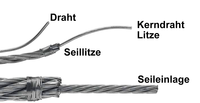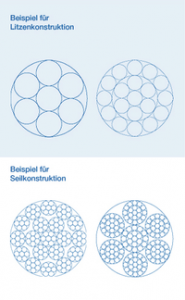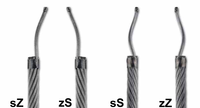Rope composition
 The fabrication of fine rope requires the highest level of precision and differs significantly from the manufacture of normal steel rope. Particular attention must also be paid to the different physical properties of the materials to be fabricated.
The fabrication of fine rope requires the highest level of precision and differs significantly from the manufacture of normal steel rope. Particular attention must also be paid to the different physical properties of the materials to be fabricated.
In general, our products are manufactured in accordance with the technical regulations and are subject to continuous quality control. The technical conditions of delivery for wire rope in accordance with EN 12385 apply.
For special materials, we confirm the characteristics that result from the material used.
Rope construction
 The primary material, the rope wire, is made into a strand and, in a further process, the strands are laid together to form a rope.
The primary material, the rope wire, is made into a strand and, in a further process, the strands are laid together to form a rope.
Direction of lay: this is the direction in which the wire in the strand is wound around the core wire, or the direction in which the strand in the rope is wound around the core strand. A differentiation is made between left-hand and right-hand lay.
For rope, a differentiation is made between ordinary lay and Lang’s lay, depending on the direction of lay in the strands and rope. Ordinary lay is when the wires in the strand are laid in an opposite direction to that of the strands in the rope. Lang’s lay is when they are laid in the same direction.
 The short terms for both types of lay are as follows:
The short terms for both types of lay are as follows:
Ordinary right-hand lay ;ngig sZ and ordinary left-hand lay = zS
Lang’s left-hand lay sS and Lang’s right-hand lay = zZ
Unless otherwise requested, we supply ordinary right-hand lay – sZ
When handling a strand or rope, it is vital that it is low-tension or low-twist.
A rope is described as low-tension or low-twist if its strands and wires do not break away (or only very slightly) from the rope bundle after the binding has been cut off or removed. A low-tension rope therefore cuts well and tends not to develop kinks or ripples.
Low-rotation or rotation-free rope
A rope is classed as rotation-free or low-rotation when it does not rotate (or only very slightly) around its longitudinal axis under the effects of a non-guided force applied in the direction of the rope axis (e.g. non-guided, suspended load in single-strand operation). This property can only be achieved by means of special constructions (e.g. multi-layer round strand rope) and manufacturing procedures. The reverse torques in the rope must be the same size, in order to achieve the desired rotation-free effect.



